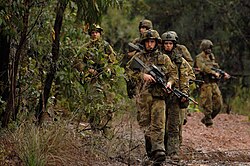Foreign relations and military

Australia's foreign relations are driven by its perception of itself as an middle power and 'good international citizen'. It has been strongly committed to multilateralism in its international relations,[1] being a foundational member of the United Nations and having led the formation of institutions such as the Cairns Group and Asia-Pacific Economic Cooperation.[2][3] It is also a member of the G20, the Organisation for Economic Co-operation and Development and the World Trade Organization.[4][5]
In recent decades, Australia's international engagement has been dominated by its close association with the United States through the ANZUS pact, and by its desire to develop relationships with Asia. In Asia, Australia is a signatory to Treaty of Amity and Cooperation in Southeast Asia and participates in the ASEAN Regional Forum and East Asia Summit.
Australia continues to engage with the United Kingdom and other former members of the British Empire as a member of the Commonwealth of Nations, in which the Commonwealth Heads of Government meetings provide the main forum for cooperation.[6] It is also party to a regional defence agreement, the Five Power Defence Arrangements, with fellow Commonwealth countries New Zealand, the United Kingdom, Malaysia and Singapore.
In the Pacific, its principle relationship is with New Zealand, the two countries having close cultural ties as well as an integrated market under the Closer Economic Relations agreement (CER).[7] The Pacific Islands Forum serves as the primary mechanism for engagement with the rest of the region.
Australia is an active advocate of international trade liberalisation,[8][9][10] and has pursued several major bilateral free trade agreements alongside its multilateral efforts. In addition to the CER, it has finalised agreements with the United States,[11] ASEAN, Singapore, Thailand and Chile, and is presently negotiating agreements with Japan and China, among others[12]
The country maintains an international aid program under which some 60 countries receive assistance. The 2005–06 budget provides A$2.5 billion for development assistance;[13] as a percentage of GDP, this contribution is less than that recommended in the UN Millennium Development Goals. Australia ranks seventh overall in the Center for Global Development's 2008 Commitment to Development Index.[14]
Australia's armed forces—the Australian Defence Force (ADF)—comprise the Royal Australian Navy (RAN), the Australian Army, and the Royal Australian Air Force (RAAF), in total numbering 80,561 personnel (including 55,068 regulars and 25,493 reservists).[15] The titular role of Commander-in-Chief is vested in the Governor-General, who appoints a Chief of the Defence Force from one of the armed services on the advice of the government.[16] The day-to-day force operations are under the command of the Chief, while the formulation of defence policy is the responsibility of the Minister and Department of Defence.
In the 2010–11 budget, defence spending was A$25.7 billion,[17] representing the 14th largest defence budget in the world but accounting for only 1.2% of global military spending.[18] Australia has been been involved in UN and regional peacekeeping, disaster relief, and armed conflict; it currently has deployed approximately 3,330 defence force personnel in varying capacities to 12 overseas operations in areas including East Timor, Solomon Islands and Afghanistan.[19]